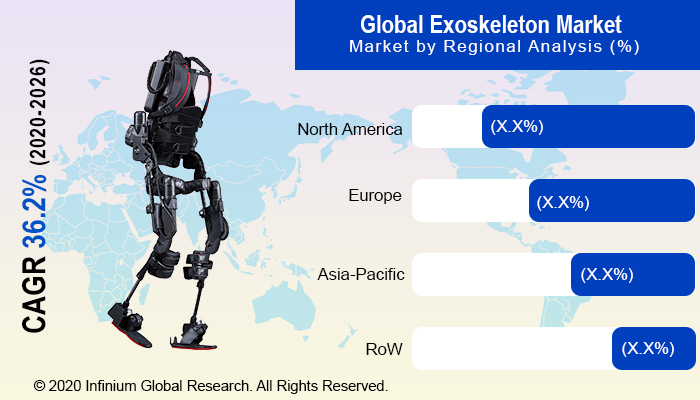Exoskeleton Market (Component - Hardware, and Software; Type - Powered, and Passive; Mobility - Stationary, and Mobile; Body Part - Lower Extremities, Upper Extremities, and Full Body; Vertical - Healthcare, Industrial, Defense, and Others): Global Industry Analysis, Trends, Size, Share and Forecasts to 2026
A recent report published by Infinium Global Research on the exoskeleton market provides an in-depth analysis of segments and sub-segments in
the global as well as regional exoskeleton market. The study also highlights
the impact of drivers, restraints, and macro indicators on the global and
regional exoskeleton market over the short term as well as long term. The
report is a comprehensive presentation of trends, forecasts, and dollar values of the global exoskeleton market. According to the report, the global exoskeleton
market is projected to grow at a CAGR of 36.2% over the forecast period of
2020-2026.
Market Insight
Exoskeletons are wearable electromechanical devices that have been
developed to enhance the physical performance of the wearer. Exoskeletons
contain rigid and resistant components that fulfill a set of functional roles
in human bodies such as protection, excretion, sensing, support, and feeding. The
current concerns over the spread of coronavirus are causing a decline in demand
for exoskeleton in the global market. Exoskeleton market finds large
applications in the healthcare sector whereas the market has slowdown due to a major
focus on coronavirus pandemic. As the spread of COVID-19 is accelerating,
global health care facilities are primarily focusing on treating and containing
this virus, which in turn has reduced the sales of exoskeletons.
However, this industry will cope up with the disruptions in the
near future due to growing innovations from manufactures. In recent times, a multidisciplinary team of doctors, robotics researchers and ergonomists from
the University of Lorraine, Inria, the CHRU of Nancy CNRS and INRS collaborated
to offer exoskeletons to medical staff working with COVID-19 patients in
medical intensive care units, in order to relieve their physical constraints.
Such innovations are expected to bring improvements in the working conditions
of medical staff. Further, an increase in the adoption of IoT in the workforce, changing
preferences, and rising need for connected devices are anticipated to sustain
the market growth over the coming years.
The rising prevalence of Parkinson’s, multiple sclerosis, and other
muscle-related diseases globally is driving the growth of the exoskeleton market. These
exoskeletons are placed on the user's body which performs as amplifiers that
augment, support, or renovate human performance. As per research, the incidence
of Parkinson’s disease increases with age and it estimated that an average of 4% of
people diagnosed with PD before age 50. Additionally, rise in the aging population
and the growing purchasing power of patients will increase the demand for
exoskeleton and anticipated to influence the market growth. Further, the growing
adoption of medical devices to support and trigger body movement will positively
impact the acceptance of exoskeletons. Moreover, they are made up of rigid
materials such as metal or carbon fiber which offer flexibility and comfortable
motion during operation. Besides that, the growing importance of exoskeleton in the manufacturing and defense sector escalates the growth of the market. These
robotic equipments are also finding a broader range of applications in industries
such as construction and warehousing. However, the high cost involved in the production
which increases the overall product cost is expected to hamper the market
growth. Moreover, recent technological advancements and continuous investment
in R&D to reduce the overall weight and relieve movement will fuel the
demand for the exoskeleton market in the forecast period.
Among the geographies, North America region held the largest share
in an industrial wearable. The US is the major market driver in the North America
region. Over 1 million people are diagnosed with Parkinson’s disease every year
in the U.S. alone. Further, the growing geriatric population, increase in the number of
organizations, and high purchasing power of patients increase the demand for the exoskeleton market. Further increasing funding for the development of
technologically advanced products will propel the market growth in this region.
However, Asia Pacific is anticipated to witness the fastest growth over the
forecast period. Growing healthcare infrastructure and the presence of a large
patient pool is expected to increase the demand in this region.

Segment Covered
The report on the global exoskeleton market covers segments such as
component, type, mobility, body part, and vertical. On the basis of component,
the sub-markets include hardware, and software. On the basis of type, the
sub-markets include powered, and passive. On the basis of mobility, the
sub-markets include stationary, and mobile. On the basis of the body part, the
sub-markets include lower extremities, upper extremities, and full body. On the
basis of vertical, the sub-markets include healthcare, industrial, defense, and
others.
Companies Profiled:
The report provides profiles of the companies in the market such
as Ekso Bionics, CYBERDYNE, INC., Ottobock, Fourier Intelligence, GOGOA
Mobility Robots, ReWalk Robotics Ltd., Lockheed Martin Corporation, Parker Hannifin
Corp., MITSUBISHI HEAVY INDUSTRIES, and Bionik Laboratories.
Report Highlights:
The report provides deep insights into the demand forecasts,
market trends, and micro and macro indicators. In addition, this report
provides insights into the factors that are driving and restraining the growth
in this market. Moreover, The IGR-Growth Matrix analysis given in the report
brings an insight into the investment areas that existing or new market players
can consider. The report provides insights into the market using analytical
tools such as Porter's five forces analysis and DRO analysis of the exoskeleton
market. Moreover, the study highlights current market trends and provides
forecast from 2020-2026. We also have highlighted future trends in the market
that will affect the demand during the forecast period. Moreover, the
competitive analysis given in each regional market brings an insight into the
market share of the leading players.
